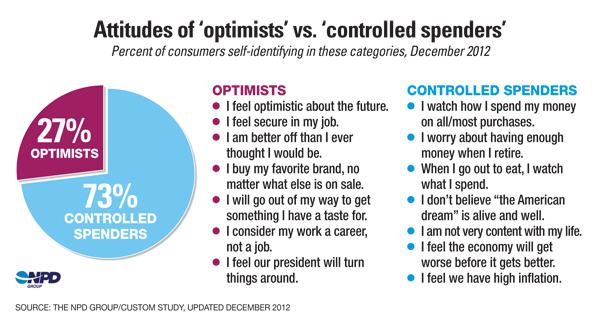Americans aren’t visiting restaurants like they used to, and they aren’t likely to ever return to their pre-recession visit levels, the Port Washington, N.Y.-based firm said.
Restaurant traffic growth slowed in December, making the battle for market share even more intense. In addition, the industry is only expected to grow 4 percent in the next decade, according to NPD research.
“In the past, consumers returned to past spending [habits], but not this time,” said Bonnie Riggs, a restaurant industry analyst at NPD. “They’ve learned to stay home. They’ve learned how to do without.”
However, experts said that savvy restaurateurs who learn how to employ effective social media marketing techniques can gain an advantage in the struggle to attract the spending-shy consumer.
According to NPD’s new report, “Planning for Growth in the New Normal Marketplace,” the fiscal crisis, attendant job losses, imposed payroll taxes, elevated gas prices and lack of confidence in the government are among the factors that have prompted consumers’ visit contraction, turning many into self-proclaimed “controlled spenders.”
NPD found that nearly three-fourths of consumers now identify themselves as controlled spenders — as opposed to “optimists,” who are generally more open handed. Controlled spenders watch how they spend their money on every purchase, including when they go out to eat.

While the recession has, technically, been over for more than three years, some consumers haven’t felt the relief yet, and many can’t foresee when — or if — it will arrive. Among controlled spenders, 46 percent said they are worse off now than they were a year ago, and 45 percent said things are about the same. Only one in 10 said they are better off now than they were last year. In addition, 55 percent of controlled spenders believe it will take three or more years for them to recover.
“Consumers are really, really concerned,” Riggs said. “We are going to be dealing with this kind of mind-set for a long, long while, and it is really going to impact the industry.”
These controlled spenders aren’t any one segment’s customers; they belong to everyone, NPD said. About half of controlled spenders are under age 49, while the other half is over 50. Forty percent have household incomes below $40,000. One-fourth fall into the middle range, with household incomes between $45,000 and $75,000. One-third are a bit more affluent, generating incomes above $75,000. Most have full-time jobs, and some are part-timers, while others are working without pay. And while many families with children have cut back on spending, 70 percent of controlled spenders come from households without children.
Compounding the negative impact of consumers’ changing dining-out behavior is a lack of projected population growth, Riggs continued. The U.S. Census Bureau announced in December that it is projecting slower population growth in the next five decades than previously expected.
“We’re not going to get the boost from that [population growth],” Riggs said. “With little or no growth in the industry, foodservice marketers face an even bigger challenge to grow their business.”
Going social, growing customers
To survive in this “new normal marketplace,” foodservice operators will have to get very creative with marketing, especially social media marketing, industry observers said.
“Social media is about friends and word-of-mouth, so it’s a really good fit for a time like this,” said Melonie Gallegos, co-founder and chief strategist of Fandom Marketing, a social marketing company.
Gallegos, together with Jack Serpa, vice president of Engage 121, a social customer relations management firm, and Linda Duke, chief executive of Duke Marketing, offered some thoughts on how operators can leverage social media to boost loyalty and grow traffic.
Join the conversation. All three experts agreed: Operators can’t compete if they aren’t even part of the conversation. While some operators are engaging in digital marketing, many more are not. For example, in a recent poll on the Restaurant SmartBrief
e-newsletter, 25 percent of readers responded that their restaurant does not have a Facebook page.
“[If you’re not using digital marketing], you’re missing a major slice of the dining population,” Serpa said. “A major slice of the dining population cannot hear you.”
Serpa added that it doesn’t take much time or money to get started. A few hours a week and as little as $25 a month can put brands in a position to connect with consumers.
“If there are fewer and fewer people dining out, those that are talking about going out [on social media] are valuable prospects,” he said.
Many brands think if they don’t have an active social media presence, their brand isn’t represented in the arena. But Gallegos said it’s happening with or without their participation.
“Social media is happening to their brand while they’re sleeping,” Gallegos said. “By not being there and listening to [the conversation], they are missing an opportunity to service their customers, leverage that word-of-mouth to get new customers [and] to retain loyalty.”
Extend existing marketing. Though it may seem foreign to restaurant operators, social media is just like other means of communicating with customers, the experts said.
“[Social media] should be an extension — an evolution — of the programs they already have in place,” Gallegos said.
Operators should approach social media just like they do other media, Duke said: “by offering promotions, giveaways, interviews and product announcements on their Facebook and Twitter pages, … [creating] savvy content and promotions that engage consumers online and offline simultaneously so that your presence is felt beyond social media.”
Monitor locations. “Something [restaurants] aren’t doing that they should do is monitor the feedback in the discussions in their location on social media,” Gallegos said.
For example, food photos are a top post on many social media platforms. Gallegos said that when someone posts a picture either of a dish at your restaurant or one you also serve, it’s a prime opportunity to reach out and connect, either cementing their existing loyalty or converting them.
Serpa said many of his clients are using programs that allow them to discover diners checking in to their restaurants or nearby competitors, then engaging with them.
Hire right. Once operators commit to using social media, they have to hire the right person to manage it. Citing a lack of time to manage it themselves, many operators hire the first person who offers to do it for free, which can be a huge mistake, Gallegos said.
“[Most] people aren’t qualified,” she said. “You’re putting that person on the front lines of your brand. They can ruin your reputation.”
Instead, Gallegos suggested finding the right person and the right digital tools. Though the cost to do this isn’t free, she said, compared to traditional media it’s cheap, and the return on investment is often much greater.
Duke agreed.
“To successfully engage and maintain a strong social media presence, restaurateurs must have a strongly articulated message and the resources to communicate it,” she said. “The big myth is that social media is free. However, it needs someone to manage it. It needs a plan and communications on a daily basis, and that requires time, effort and a human.”
Nation’s Restaurant News has an exclusive agreement to obtain the NPD Group data and research findings that appear on the Consumer Trends page.





